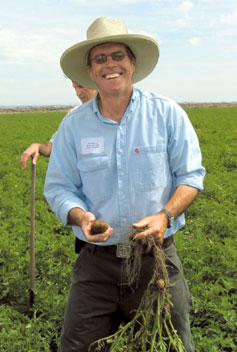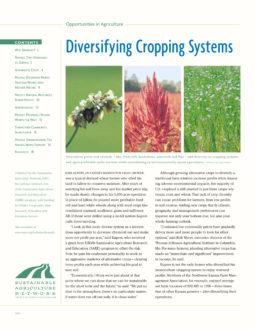
Marketing is probably the most important consideration when contemplating new crops. While conventional grain producers tend to use the relatively straightforward route of taking the harvested crop to the local grain elevator, diversified growers should not expect convenient delivery with new or alternative crops.
Instead, you should consider:
- Researching the market before planting.
- Developing a marketing plan with information on prices, delivery points and sales contracts. (For help, consider Building a Sustainable Business.)
- Creating long-distance sales channels, such as the Internet.
- Establishing relationships with buyers.
- Asking retailers or wholesalers who handle similar food, feed or fiber products if they are willing to test a small quantity of a new product in the marketplace. Many growers also sell successfully to consumers; this approach may involve more cleaning, processing and packaging but often brings a higher profit.
- Receiving endorsement by a third-party verifier that advertises sustainable production systems. The Food Alliance of Portland, Ore., helped Kupers gain access to markets. “Today’s consumer desires more knowledge of how his or her food was produced,” he said. “My strategy is to market my production system.”
Kupers spends most of his time identifying trends and tracking down the opportunities they present. He describes his marketing strategy as “listening, reading, going to the marketplaces, understanding what today’s consumer is looking for and then trying to develop a product the consumer will desire.” Visits to national pet store chains and discount supermarts convinced him that backyard wildlife feeding was taking off. Kupers now sells his safflower and sunflower seed to a national bird feed manufacturer-distributor in nearby Spokane, rather than paying the freight to ship it 300 miles to a processor.
In South Dakota, Rick Heintzman direct markets his golden flaxseed under the trademarked “Dakota Flax Gold” label. The healthful properties of flaxseed oil – it is high in omega-3 fatty acid, which is believed to help lower heart attack risks – and demand for linen clothing have renewed interest in flax. Heintzman manufactures, stores and distributes the product himself. By selling 1- to 50-pound packages directly to consumers, clinics, hospitals and health food stores, Heintzman boosts his crop’s value to $168 per bushel. That’s almost 50 times what his flax would bring at the local grain elevator.
In general, carefully written contracts are advantageous for sellers of alternative crops, said Myers. “First and foremost, farmers know they have a market. They also have a price up front, so they can better determine if they can make a profit.”
Buckwheat, crambe and sesame typically are grown under contract while canola, sunflowers and nuts normally are not. Contracts are sometimes available for safflower, amaranth, millets and alternative legumes.
Some marketing contracts require delivery of a certain amount of product. If growers fail to produce that much, they may have to purchase the difference, at high cost, from another source to fulfill the contract. For more information, consult Agricultural Production Contracts from the University of Minnesota. (See “Resources”)
In Regent, N.D., Vern Mayer sells all of his buckwheat, most of his flax and half of his sunflowers under contract. His buckwheat prices go up and down with the price of wheat and his sunflower prices follow soybeans, but his flax prices ripple mildly and more independently.
Compared to conventional growers, Mayer said he is “as profitable – not more – from a strictly cash standpoint. But what encourages me is that I know that what I’m doing is building my soil and reversing the decline in organic matter. There’s a certain sense of pride and a certain sense of stewardship that goes along with knowing that every year your land is becoming more productive than it was before.”
Challenges to Diversifying Your System
Like any new venture, diversifying your farm will pose some new challenges. However, being prepared and calling on experts for advice (see “Resources”) can help you surmount most obstacles. Some of the most common include:
- Market development. Expect to conduct substantial research.
- Information on varietal performance, best management practices and post-harvest handling and storage may be hard to find. See “Resources” for groups that can help.
- Seed selection may be limited and plant establishment may be difficult.
- Pesticides labeled for alternative crops may not be available. Diverse systems can help break pest life cycles.
- A need to modify or replace equipment. Consider that hand labor may occasionally be the only viable option.
- Harvesting, post-harvest handling and storage considerations, with possible additional costs.
- Locating local businesses and infrastructure for handling, transporting, processing, storing and marketing.
- Price swings for alternative crops. The more diverse your crop list, the better you can buffer your economic risk.
- Contracts. Sometimes contracts are not available for alternative crops every year – or at all.
